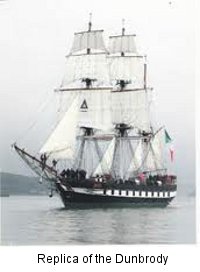Journal Volume 5 2006
Surplus People from Newcastle and Ballyvolan
By Jim Rees
Introduction
A relatively new attraction for historical society outings can be found moored alongside the quay at New Ross. It is the replica famine ship Dunbrody. Ireland has two such sailing ships, the Kerry-based Jeanie Johnston, whose financial problems during her building were seldom out of the news, and the Dunbrody. The Jeanie Johnston's problems seem to be behind her now and she has crossed the Atlantic to explain Irish famine emigration to many thousands of people in ports from Florida to Quebec.  The Dunbrody is New Ross built and based, and is now one of County Wexford's major attractions. Although she is seaworthy, and may take to the open waters in the future, she is primarily an exhibit to explain mid-19th century emigration to America. To keep her as authentic as possible, she has not been fitted with the engines which modern regulations require before she can put to sea. That's the problem with such projects. The more a vessel is compromised to meet modern safety standards, the less of a replica of a 19th century ship she is. The Dunbrody has resisted the temptation to reduce exhibition space in order to meet sea-going criteria, although future policy may alter that. For now, she is what she was built as, a replica of an engine-less Quebec-built sailing ship of the same name. The original Dunbrody was owned by the New Ross shippers Graves & Company, and was engaged mainly in the famine emigration trade, leaving from the quay alongside which her replica is now moored.1
The Dunbrody is New Ross built and based, and is now one of County Wexford's major attractions. Although she is seaworthy, and may take to the open waters in the future, she is primarily an exhibit to explain mid-19th century emigration to America. To keep her as authentic as possible, she has not been fitted with the engines which modern regulations require before she can put to sea. That's the problem with such projects. The more a vessel is compromised to meet modern safety standards, the less of a replica of a 19th century ship she is. The Dunbrody has resisted the temptation to reduce exhibition space in order to meet sea-going criteria, although future policy may alter that. For now, she is what she was built as, a replica of an engine-less Quebec-built sailing ship of the same name. The original Dunbrody was owned by the New Ross shippers Graves & Company, and was engaged mainly in the famine emigration trade, leaving from the quay alongside which her replica is now moored.1
All very interesting, but what has it got to do with north-east Wicklow? The original Dunbrody was used in the emigration programme of the Fitzwilliam estate, and part of that estate was located at Newcastle and Ballyvolan. But let us take it from the beginning.
1840s Emigration
The series of potato crop failures which occurred in the second half of the 1840s deprived the vast majority of Irish rural dwellers of their staple diet, and created a situation in which emigration was for many the only alternative to starvation. In the ten years between 1845 and 1854 over 2,250,000 Irish people crossed the Atlantic in the most primitive conditions. Less than 500,000 of them sailed to Canada, the rest went to the United States. The vast majority of these refugees managed to scrape together the fare to make their own way to what they hoped would be a better life. Some, however, were given what was euphemistically called 'assisted passage'. That is, they received inducements from their landlords to leave, so that they would not become inmates of workhouses or recipients of outdoor relief and so become a burden on the ratepayers, many of whom were the landlords in question.

